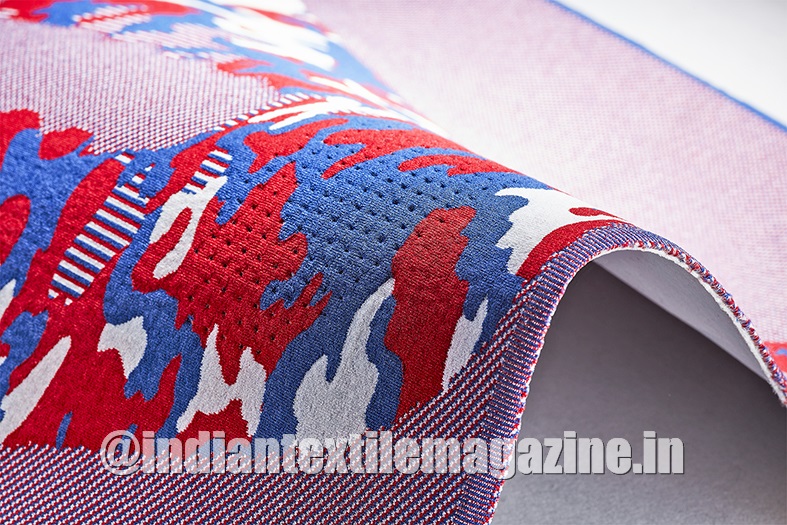Compared to warp knitting machines, circular knitting machines create shoe upper material that offers better breathability, more design possibilities and less waste. Even when used for more casual physical activity, athletic shoes must be designed in a way that keeps feet cool and dry. Because of this, the vast majority of shoe upper material is made using spacer fabric. This is an incredibly breathable fabric that is highly adept at dissipating heat and moisture, due to a 3D structure that interconnects two pieces of textile with yarn in a way that induces airflow.
Unlike its toxic, laminated-layer foam predecessor, spacer fabric is made using a single, synthetic fiber-type fabric. This not only enables shoe uppers to be easily up-cycled at the end of their life, but also reduces the cost of processing while simultaneously making shoes more lightweight.
In recent years, there has been a palpable global trend towards athletic footwear, and the shoe upper manufacturing industry has responded accordingly. However, most space fabric manufacturing has been limited to production on warp knitting machines. While warp knitting machines are 8-9 times more productive than circular knitting machines, they offer several distinct disadvantages and present a clear barrier to entry for anyone looking to carve out a piece of the athletic footwear market or for manufacturers who operate on a smaller scale.
Higher performing spacer fabric
Spacer fabric performs extremely well in terms of breathability. The reason for this lies in its sandwich-like structure that combines two textile substrates with interconnected monofilament yarn. The hollow structure creates a ventilation effect that increases airflow, while the thick fabric adds an extra layer of comfort.
Until relatively recently, the majority of spacer fabric was produced on warp knitting machines. While more efficient in terms of production value, the spacer fabric produced on a warp knitting machine tends to be rather stiff and sturdy, lacking an element of comfort that is essential for athletic shoe wearers. In contrast, circular knitting machines produce a spacer fabric that is much softer and more flexible, offering a snug, almost sock-like fit, while also providing comprehensive foot protection and abrasion resistance.
More design possibilities
Unlike warp knitting machines that can only knit different colored patterns by changing the beams – a process that requires several hours – circular knitting machines can easily match various yarns and knits to produce different textures and patterns. As such, manufacturers can quickly and easily satiate market demand for more shoe design options.
There are several benefits to being able to execute different design possibilities on a single machine. First of all, manufacturers are able to produce certain styles on a smaller scale. Not only is this essential for first-time shoe upper manufacturers, but is also ideal for those who want to test a certain style on a smaller scale before ramping up production.
Second, the circular knitting machine eliminates the labor- and time-intensive post-production dyeing step, allowing manufacturers to streamline production and cut costs.
While warp knitting machines cost around $500,000, the average cost of a circular knitting machines is just $180,000. Established shoemakers can more easily transition into knitting spacer fabrics by investing in circular knitting machines to either replace or complement any existing warp knitting machines.
For those who want to produce shoes on a smaller scale – for example, apparel manufacturers looking to expand further into footwear or new entrants to the industry – the substantial cost of a warp knitting machine may be dissuasive enough to avoid making the investment. By investing in the relatively more affordable circular knitting machine instead, manufacturers are able to more easily transition into shoe upper manufacturing without sacrificing a hefty sum.
More sustainable
Warp knitting machines produce large stretches of fabric at a time, which means the fabric still needs to be cut and sewn after production. This process is not only time consuming, but also generates a significant amount of waste – as much as 25%, according to some estimates. In comparison, circular knitting machines only waste approximately 10% of the original fabric.
Furthermore, as companies around the world are scrambling to improve their sustainability scores, transitioning to less energy-intensive circular machines is one way to reduce electricity consumption – not only helping to improve corporate image, but also presenting attractive savings possibilities on manufacturers’ utility bills.
The future of spacer fabrics
While spacer fabric all but dominates the industry in terms of breathability, knitting specialists continue to explore new ways to make spacer fabric even more breathable. A recent innovation in circular knitting technology enables spacer fabrics with fully perforated holes, further increasing airflow, to produce the world’s most breathable shoe upper material. In comparison, warp knitting machines are currently only able to produce spacer fabric with blind holes. As the spacer fabric technology continues to develop, this new innovation will help initiate even more possibilities for the future of footwear.
Pailung Products and Solutions
Pailung, one of the world’s largest knitting machinery companies, is the sole manufacturer of circular knitting machines that produce spacers with knitted eyelets. The knitted eyelet is breaking through the spacer fabric bottleneck to create the world’s most breathable shoe upper material. ShupperKnit circular knitting machines can knit spacers up to 6 mm thick.
While circular knitting machines generally create fabrics with enhanced breathability, the addition of knitted eyelets further increases airflow for an even more comfortable wearing experience. This new technology allows shoemakers to increase breathability, while incorporating all the benefits of circular knitting technology – lower initial cost, less environmental impact, and more design possibilities – into spacer shoe uppers.
Moreover, with an exclusive conversion kit, double-sided fabrics can also be knitted using the same machine without making any other changes to the knitting machine – offering a future-proof solution and further increasing application possibilities.
